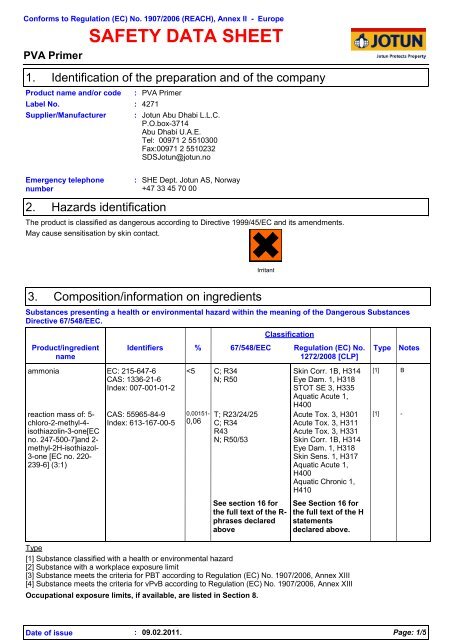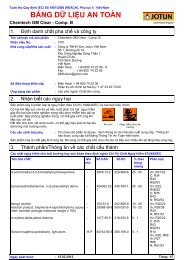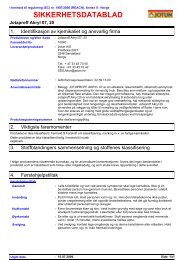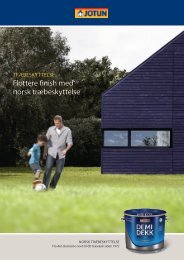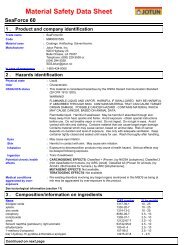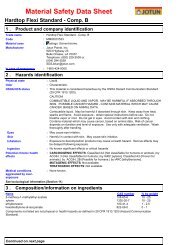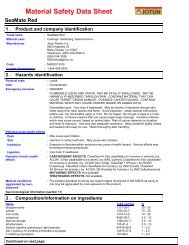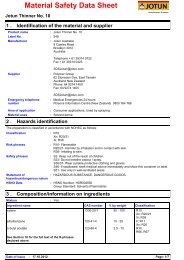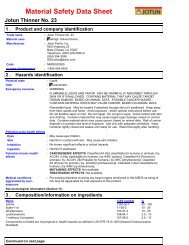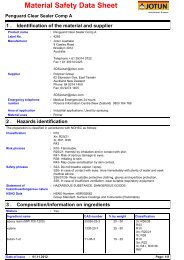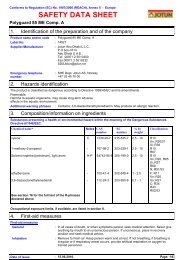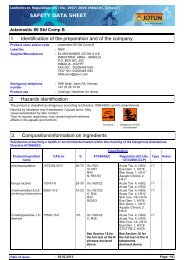PVA Primer - Jotun
PVA Primer - Jotun
PVA Primer - Jotun
You also want an ePaper? Increase the reach of your titles
YUMPU automatically turns print PDFs into web optimized ePapers that Google loves.
Conforms to Regulation (EC) No. 1907/2006 (REACH), Annex II - Europe<strong>PVA</strong> <strong>Primer</strong>1.SAFETY DATA SHEETIdentification of the preparation and of the companyProduct name and/or code :Label No. : 4271Supplier/Manufacturer:<strong>PVA</strong> <strong>Primer</strong><strong>Jotun</strong> Abu Dhabi L.L.C.P.O.box-3714Abu Dhabi U.A.E.Tel: 00971 2 5510300Fax:00971 2 5510232SDS<strong>Jotun</strong>@jotun.noEmergency telephonenumber2.Hazards identification:SHE Dept. <strong>Jotun</strong> AS, Norway+47 33 45 70 00The product is classified as dangerous according to Directive 1999/45/EC and its amendments.May cause sensitisation by skin contact.Irritant3.Composition/information on ingredientsSubstances presenting a health or environmental hazard within the meaning of the Dangerous SubstancesDirective 67/548/EEC.Product/ingredientnameammonia EC: 215-647-6CAS: 1336-21-6Index: 007-001-01-2reaction mass of: 5-chloro-2-methyl-4-isothiazolin-3-one[ECno. 247-500-7]and 2-methyl-2H-isothiazol-3-one [EC no. 220-239-6] (3:1)IdentifiersCAS: 55965-84-9Index: 613-167-00-5% 67/548/EEC Regulation (EC) No. Type1272/2008 [CLP]
<strong>PVA</strong> <strong>Primer</strong>4.First-aid measuresGeneralInhalationSkin contactEye contactIngestion5.First-aid measuresFire-fighting measuresExtinguishing media :Extinguishing media not tobe usedRecommendations:::::In all cases of doubt, or when symptoms persist, seek medical attention. Never giveanything by mouth to an unconscious person. If unconscious, place in recoveryposition and seek medical advice.Remove to fresh air. Keep person warm and at rest. If not breathing, if breathing isirregular or if respiratory arrest occurs, provide artificial respiration or oxygen bytrained personnel.Remove contaminated clothing and shoes. Wash skin thoroughly with soap andwater or use recognised skin cleanser. Do NOT use solvents or thinners.Check for and remove any contact lenses. Immediately flush eyes with running waterfor at least 15 minutes, keeping eyelids open. Seek immediate medical attention.If swallowed, seek medical advice immediately and show the container or label.Keep person warm and at rest. Do not induce vomiting.Recommended: alcohol-resistant foam, CO2, powders, water spray.: Do not use water jet.6. Accidental release measuresPersonal precautionsSpill: Fire will produce dense black smoke. Exposure to decomposition products maycause a health hazard. Appropriate breathing apparatus may be required.Cool closed containers exposed to fire with water. Do not release runoff from fire todrains or watercourses.::Exclude sources of ignition and ventilate the area. Avoid breathing vapour or mist.Refer to protective measures listed in sections 7 and 8.Contain and collect spillage with non-combustible, absorbent material e.g. sand,earth, vermiculite or diatomaceous earth and place in container for disposalaccording to local regulations (see section 13). Preferably clean with a detergent.Avoid using solvents.Note: see section 8 for personal protective equipment and section 13 for waste disposal.7.HandlingHandling and storage:Prevent the creation of flammable or explosive concentrations of vapours in air andavoid vapour concentrations higher than the occupational exposure limits.In addition, the product should only be used in areas from which all naked lights andother sources of ignition have been excluded. Electrical equipment should beprotected to the appropriate standard.To dissipate static electricity during transfer, earth drum and connect to receivingcontainer with bonding strap. Operators should wear antistatic footwear and clothingand floors should be of the conducting type.Keep away from heat, sparks and flame. No sparking tools should be used.Avoid contact with skin and eyes. Avoid the inhalation of dust, particulates, spray ormist arising from the application of this preparation. Avoid inhalation of dust fromsanding.Eating, drinking and smoking should be prohibited in areas where this material ishandled, stored and processed.Put on appropriate personal protective equipment (see Section 8).Never use pressure to empty. Container is not a pressure vessel.Always keep in containers made from the same material as the original one.Comply with the health and safety at work laws.Information on fire and explosion protectionVapours are heavier than air and may spread along floors. Vapours may formexplosive mixtures with air.When operators, whether spraying or not, have to work inside the spray booth,ventilation is unlikely to be sufficient to control particulates and solvent vapour in allcases. In such circumstances they should wear a compressed air-fed respiratorduring the spraying process and until such time as the particulates and solventvapour concentration has fallen below the exposure limits.Date of issue : 09.02.2011.Page: 2/5
<strong>PVA</strong> <strong>Primer</strong>Storage:Store in accordance with local regulations.Notes on joint storageKeep away from: oxidising agents, strong alkalis, strong acids.Additional information on storage conditionsObserve label precautions. Store in a dry, cool and well-ventilated area. Keep awayfrom heat and direct sunlight. Keep away from sources of ignition. No smoking.Prevent unauthorised access. Containers that have been opened must be carefullyresealed and kept upright to prevent leakage.8. Exposure controls/personal protectionEngineering measures:Provide adequate ventilation. Where reasonably practicable, this should be achievedby the use of local exhaust ventilation and good general extraction. If these are notsufficient to maintain concentrations of particulates and solvent vapours below theOEL, suitable respiratory protection must be worn.Personal protective equipmentRespiratory system :Skin and body:Hands:If workers are exposed to concentrations above the exposure limit, they must useappropriate, certified respirators. Use respiratory mask with charcoal and dust filterwhen spraying this product.(as filter combination A2-P2). In confined spaces, usecompressed-air or fresh-air respiratory equipment. When use of roller or brush,consider use of charcoalfilter.Personnel should wear antistatic clothing made of natural fibres or of hightemperature-resistantsynthetic fibres.For prolonged or repeated handling, use the following type of gloves: gloves: nitrile.Eyes:Barrier creams may help to protect the exposed areas of the skin but should not beapplied once exposure has occurred.For right choice of glove materials, with focus on chemical resistance and time ofpenetration, seek advice by the supplier of chemical resistant gloves.The user must check that the final choice of type of glove selected for handling thisproduct is the most appropriate and takes into account the particular conditions ofuse, as included in the user's risk assessment.Use safety eyewear designed to protect against splash of liquids.9.Physical and chemical propertiesPhysical stateOdour::Liquid.Characteristic.Colour: Various colours.Density : 1.2 g/cm 3Solubility: Easily soluble in the following materials: cold water and hot water.10.Stability and reactivityStable under recommended storage and handling conditions (see section 7).Hazardous decomposition products: carbon monoxide, carbon dioxide, smoke, oxides of nitrogen.Keep away from the following materials to prevent strong exothermic reactions: oxidising agents, strong alkalis, strongacids.11.Toxicological informationThere is no data available on the preparation itself. The preparation has been assessed following the conventionalmethod of the Dangerous Preparations Directive 1999/45/EC and classified for toxicological hazards accordingly. Seesections 2 and 15 for details.Exposure to component solvent vapour concentrations in excess of the stated occupational exposure limit may result inadverse health effects such as mucous membrane and respiratory system irritation and adverse effects on the kidneys,liver and central nervous system. Symptoms and signs include headache, dizziness, fatigue, muscular weakness,drowsiness and, in extreme cases, loss of consciousness.Solvents may cause some of the above effects by absorption through the skin. Repeated or prolonged contact with thepreparation may cause removal of natural fat from the skin, resulting in non-allergic contact dermatitis and absorptionthrough the skin.If splashed in the eyes, the liquid may cause irritation and reversible damage.Ingestion may cause nausea, diarrhea and vomiting.Date of issue : 09.02.2011.Page: 3/5
<strong>PVA</strong> <strong>Primer</strong>This takes into account, where known, delayed and immediate effects and also chronic effects of components fromshort-term and long-term exposure by oral, inhalation and dermal routes of exposure and eye contact.Contains reaction mass of: 5-chloro-2-methyl-4-isothiazolin-3-one[EC no. 247-500-7]and 2-methyl-2H-isothiazol-3-one[EC no. 220-239-6] (3:1). May produce an allergic reaction.12.Ecological informationThere is no data available on the preparation itself.Do not allow to enter drains or watercourses.The preparation has been assessed following the conventional method of the Dangerous Preparations Directive1999/45/EC and is not classified as dangerous for the environment but contains a substance or substances dangerousfor the environment. See section 2 for details.Aquatic ecotoxicityProduct/ingredient name Test ResultSpeciesammonia - Acute EC50 24 mg/l Daphnia -Daphniamagna- Acute LC50 0,53 mg/l Fish -Onchorhynchusreaction mass of: 5-chloro-2-methyl-4-isothiazolin-3-one[EC no. 247-500-7]and2-methyl-2H-isothiazol-3-one [EC no. 220-239-6] (3:1)Ecological informationBiodegradabilitymykiss- Acute EC50 0,16 mg/l Daphnia -Daphniamagna- Acute EC50 0,01 mg/l Algae -Selenastrumcapricornutum- Acute LC50 0,19 mg/l Fish - Trout -OncorhynchusmykissExposure48 hours96 hours48 hours72 hours96 hoursProduct/ingredient name Aquatic half-life Photolysis Biodegradabilityammonia - - Not readilyreaction mass of: 5-chloro-2-methyl-4-isothiazolin-3-one[EC no. 247-500-7]and 2-methyl-2H-isothiazol-3-one[EC no. 220-239-6] (3:1)- - Not readily13.Disposal considerationsDo not allow to enter drains or watercourses. Material and/or container must be disposed of as hazardous waste.European waste catalogue(EWC): 08 01 11* Waste paint and varnish containing organic solvents or other dangeroussubstances. If this product is mixed with other wastes, this code may no longer apply.If mixed with other wastes, the appropriate code should be assigned. For furtherinformation, contact your local waste authority.14. Transport informationTransport within user’s premises: always transport in closed containers that are upright and secure. Ensure thatpersons transporting the product know what to do in the event of an accident or spillage.This preparation is not classified as dangerous according to international transport regulations (ADR/RID, IMDG orICAO/IATA).15.Regulatory informationEU regulationsHazard symbol or symbols: The product is classified and labelled for supply in accordance with the Directive1999/45/EC as follows::IrritantDate of issue : 09.02.2011.Page: 4/5
<strong>PVA</strong> <strong>Primer</strong>Risk phrasesSafety phrasesContains16. Other informationCEPE Classification : 1Full text of abbreviated HstatementsFull text of abbreviated Rphrases::R43- May cause sensitisation by skin contact.S2- Keep out of the reach of children.S23- Do not breathe vapour / spray.S24- Avoid contact with skin.S37- Wear suitable gloves.S46- If swallowed, seek medical advice immediately and show this container or label.S51- Use only in well-ventilated areas.: reaction mass of: 5-chloro-2-methyl-4-isothiazolin-3-one[EC no. 247-500-7]and 2-methyl-2H-isothiazol-3-one [EC no. 220-239-6] (3:1): H301 Toxic if swallowed.H311 Toxic in contact with skin.H314 Causes severe skin burns and eye damage.H317 May cause an allergic skin reaction.H318 Causes serious eye damage.H331 Toxic if inhaled.H335 May cause respiratory irritation.H400 Very toxic to aquatic life.H410 Very toxic to aquatic life with long lasting effects.: R23/24/25- Toxic by inhalation, in contact with skin and if swallowed.R34- Causes burns.R43- May cause sensitisation by skin contact.R50- Very toxic to aquatic organisms.R50/53- Very toxic to aquatic organisms, may cause long-term adverse effects in theaquatic environment.This Safety Data Sheet is prepared in accordance with Annex II to Regulation (EC) No 1907/2006.Date of issue : 09.02.2011.Version: 1Indicates information that has changed from previously issued version.Notice to readerThe information in this SDS is based on the present state of our knowledge and on current laws. The productis not to be used for purposes other than those specified under section 1 without first obtaining writtenhandling instructions. It is always the responsibility of the user to take all necessary steps to fulfil thedemands set out in the local rules and legislation. The information in this SDS is meant to be a description ofthe safety requirements for our product. It is not to be considered a guarantee of the product's properties.Date of issue : 09.02.2011.Page: 5/5


